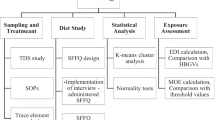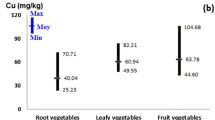Abstract
The estimated daily intakes (EDIs) of six trace elements (Cu, Zn, Pb, Cd, Hg, and As) in vegetables (leafy vegetable, i.e., bok choy, fruit vegetables, i.e., cucumber and tomato, and other categories, i.e., mushroom, kidney bean, and potato), cereals (rice and wheat flour), and meats (pork, mutton, and beef) most commonly consumed by adult inhabitants of Qiqihar, Northeastern China, were determined to assess the health status of local people. The average EDIs of Cu, Zn, Pb, Cd, Hg, and As were with 20.77 μg (kg bw)−1 day−1 of Cu, 288 μg (kg bw)−1 day−1 of Zn, 2.01 μg (kg bw)−1 day−1 of Pb, 0.41 μg (kg bw)−1 day−1 of Cd, 0.01 μg (kg bw)−1 day−1 of Hg, and 0.52 μg (kg bw)−1 day−1 of As, respectively, which are below the daily allowance recommended by FAO/WHO. However, the maximum EDIs of Pb and Cd were 4.56 μg (kg bw)−1 day−1 and 1.68 μg (kg bw)−1 day−1, respectively, which are above the recommended levels [i.e., 3.58 μg (kg bw)−1 day−1 for Pb and 1.0 μg (kg bw)−1 day−1 for Cd] by FAO/WHO. This finding indicates that the potential health risk induced by daily ingestion of Pb and Cd for the local residents should receive a significant concern. Similarly, we detected elevated Pb and Cd concentrations, i.e., with average of 13.58 and 0.60 mg kg−1 dw, respectively, in the adult scalp hairs. Consumption of rice, potato, bok choy, and wheat flour contributed to 75 and 82% of Pb and Cd daily intake from foodstuffs. Nevertheless, human scalp hair is inappropriate biological material for determination of the nutritional status of trace elements in this region.

Similar content being viewed by others
References
Afridi, H. I., Kazi, T. G., Kazi, G. H., Jamali, M. K., & Shar, G. Q. (2006). Essential trace and toxic element distribution in the scalp hair of Pakistani myocardial infarction patients and controls. Biological Trace Element Research, 113, 19–34.
Allen, S. E., Grimshaw, H. M., & Rowland, A. P. (1986). Chemical analysis. In P. D. More & S. B. Chapman (Eds.), Methods in plant ecology (pp. 285–344). Oxford: Blackwell Scientific Publication.
Chen, Y. D., Zhou, J. M., Xin, L., Feng, Y. F., Hang, X. S., & Wang, H. Y. (2015). Characteristics of heavy metals and phosphorus in farmland of Hailun City, Heilongjiang Province. Soils, 47, 965–972. (in Chinese).
Cui, J., Zang, S. Y., Zhai, D. L., & Wu, B. (2014). Potential ecological risk of heavy metals and metalloid in the sediments of Wuyur River basin, Heilongjiang Province, China. Ecotoxicology, 23, 589–600.
Duruibe, J. O., Ogwuegbu, M. D. C., & Egwurugwu, J. N. (2007). Heavy metal pollution and human biotoxic effects. International Journal of Physical Sciences, 2, 112–118.
FAO/WHO. (1997). Food consumption and exposure assessment of chemicals. Report of FAO/WHO consultation. Geneva: WHO.
Frisch, M., & Schwartz, B. S. (2002). The pitfalls of hair analysis for toxicants in clinical practice: three case reports. Environmental Health Perspectives, 110, 433–436.
González-Muñz, M. J., & Meseguer, A. P. I. (2008). Monitoring heavy metal contents in food and hair in a sample of young Spanish subjects. Food and Chemical Toxicology, 46, 3048–3052.
Lee, H. S., Cho, Y. H., Park, S. O., Kye, S. H., Kim, B. H., Hahm, T. S., et al. (2006). Dietary exposure of the Korean population to arsenic, cadmium, lead and mercury. Journal of Food Composition and Analysis, 19(S), 31–37.
Liu, H. Y., Probst, A., & Liao, B. H. (2005). Metal contamination of soils and crops affected by the Chenzhou lead zinc mine spill (Hunan China). Science of the Total Environment, 339, 153–166.
Loutfy, N., Fuerhacker, M., Tundo, P., Raccanelli, S., El Dien, A. G., & Ahmed, M. T. (2006). Dietary intake of dioxins and dioxin-like PCBs, due to the consumption of dairy products, fish/seafood and meat from Ismailia city, Egypt. Science of the Total Environment, 370, 1–8.
Luo, J. M., Ye, Y. J., & Gao, Z. Y. (2015). Arsenic Content in Red-crowned Crane (Grus japonensis) and Invertebrates at the Bottom of Food Chain in Zhalong Wetland, Northeastern China. Ecological Research, 30, 803–812.
Luo, J. M., Ye, Y. J., Gao, Z. Y., Wang, Y. J., & Wang, W. F. (2014a). Characterization of heavy metal contamination in the habitat of red-crowned crane (Grus japonensis) in Zhalong Wetland, Northeastern China. Bulletin of Environment Contamination and Toxicology, 93, 327–333.
Luo, J. M., Ye, Y. J., & Wang, Y. J. (2014b). Dietary Exposure of the Red-Crowned Crane (Grus japonensis) to Total and Methyl Mercury in Zhalong Wetland, Northeastern China. Biological Trace Element Research, 159, 210–218.
Luo, J. M., Yin, X. R., Ye, Y. J., Wang, Y. J., Zang, S. Y., & Zhou, X. (2013). Pb and Cd bioaccumulations in the habitat and preys of red-crowned cranes (Grus japonensis) in Zhalong Wetland, Northeastern China. Biological Trace Element Research, 156, 134–143.
Mikeley, N., Carneiro, M. T. W. D., & Silveira, C. L. P. D. (1998). How reliable are human hair reference intervals for trace elements. Science of the Total Environment, 218, 9–17.
Muchuweti, M., Birkett, J. W., Chinyanga, E., Zvauya, R., Scrimshaw, M. D., & Lester, J. N. (2006). Heavy metal content of vegetables irrigated with mixtures of wastewater and sewage sludge in Zimbabwe: Implications of human health. Agriculture, Ecosystems & Environment, 112, 41–48.
Nowak, B., & Chmielnicka, J. (2000). Relationship of lead and cadmium to essential elements in hair, teeth and nails of environmental exposed people. Ecotoxicology Environmental Safety, 46, 265–274.
Pereira, R., Ribeiro, R., & Goncalves, F. (2004). Scalp hair analysis as a tool in assessing human exposure to heavy metals (S. Domingos mine, Portugal). Science of the Total Environment, 327, 81–92.
Qing, J. (2004). The upper limit of normal value of hair Pb, Cd, As, Hg in Chinese resident. Guangdong Trace Element Science, 11, 29–37. (in Chinese).
Rodrigues, J., Batista, B. L., Nunes, J. A., Passons, C. J. S., & Barbosa, F. J. (2008). Evaluation of the use of human hair for biomonitoring the deficiency of essential and exposure to toxic elements. Science of the Total Environment, 405, 370–376.
Santos, E., Lauria, D., & Porto da Silveira, C. (2004). Assessment of daily intake of trace elements due to consumption of foodstuffs by adult inhabitants of Rio de Janeiro city. Science of the Total Environment, 327, 69–79.
Schuhmacher, M., Domingo, J. L., Llobet, J. M., & Corbella, J. (1991). Lead in children’s hair as related to exposure in Tarragona Province, Spain. Science of the Total Environment, 104, 167–173.
Singh, A., Sharma, R. K., Agrawal, M., & Marshall, F. M. (2010). Health risk assessment of heavy metals via dietary intake of foodstuffs from the wastewater irrigated site of a dry tropical area of India. Food and Chemical Toxicology, 48, 611–619.
Song, B., Lei, M., Chen, T., Zheng, Y., Xie, Y., Li, X., et al. (2009). Assessing the health risk of heavy metals in vegetables to the general population in Beijing, China. Journal of Environmental Sciences, 21, 1702–1709.
Tripathi, R. M., Raghumath, R., & Krishnamoorthy, T. M. (1997). Dietary intake of heavy metals in Bombay city, India. Science of the Total Environment, 208, 149–159.
Wang, T., Fu, J., Wang, Y., Liao, C., Tao, Y., & Jiang, G. (2009). Use of scalp hair as indicator of human exposure to heavy metals in an electronic waste recycling area. Envionmental Pollution, 157, 2245–2251.
WHO/FAO (2011) Jiont FAO/WHO food standard programme–codex committee on contaminants in foods. In 5th session, Hague, Netherlands, CF/5 INF/1.
Zhang, Z., Song, X., Wang, Q., & Lu, X. (2012a). Cd and Pb contents in soil, plants, and grasshoppers along a pollution gradient in Huludao City, Northeast China. Biological Trace Element Research, 145, 403–410.
Zhang, L., Wang, C., Wang, H., & Liu, X. (2012b). Research on change of nutrition pattern of population (2001–2010) in Heilongjiang province, Northeastern China. Journal of Resources and Ecology, 41, 830–832. (in Chinese).
Zheng, N., Wang, Q., Zhang, X., Zheng, D., Zhang, Z., & Zhang, S. (2007). Population health risk due to dietary intake of heavy metals in the industrial area of Huludao city, China. Science of the Total Environment, 387, 96–104.
Zhuang, P., Mcbride, M. B., Xia, H., Li, N., & Li, Z. (2009). Health risk from heavy metals via consumption of food crops in the vicinity of Dabaoshan mine, South China. Science of the Total Environment, 407, 1551–1561.
Acknowledgements
This research was supported by the National Key Research and Development Program of P R china (Grant No. 2016YFC0501201-03), the Heilongjiang Provincial Nature Fund of China (Grant No. C2016058), and Research Innovation Program for College Graduates of Qiqihar University (YJSCX2016-ZD18).
Author information
Authors and Affiliations
Corresponding author
Rights and permissions
About this article
Cite this article
Luo, J., Meng, J., Ye, Y. et al. Population health risk via dietary exposure to trace elements (Cu, Zn, Pb, Cd, Hg, and As) in Qiqihar, Northeastern China. Environ Geochem Health 40, 217–227 (2018). https://doi.org/10.1007/s10653-016-9895-0
Received:
Accepted:
Published:
Issue Date:
DOI: https://doi.org/10.1007/s10653-016-9895-0




